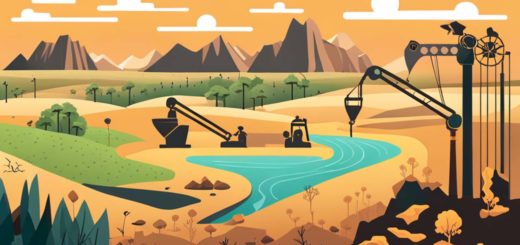The Impact of Carbon Footprint on Australia: Causes, Effects, and Solutions

It’s no secret that climate change is a hot topic in Australia and around the world. One key contributor to climate change is our carbon footprint. The term carbon footprint refers to the total greenhouse gas emissions caused directly or indirectly by human activities. These activities can range from driving a car to consuming goods and services.
In Australia, it’s particularly important to discuss our carbon footprint because, as a nation, we’re one of the highest per capita emitters of greenhouse gases. This article aims to provide an in-depth look at the causes, effects, and potential solutions to reducing our carbon footprint Down Under. We’ll also explore real-life examples and case studies of sustainable initiatives that have made a positive impact.
Causes of Carbon Footprint in Australia
Understanding the main causes of carbon footprint in Australia is crucial for addressing the issue. Let’s dive into some of the major factors contributing to our nation’s carbon emissions:
High reliance on fossil fuels
Coal, oil, and natural gas are the primary sources of energy in Australia, responsible for more than 70% of our electricity generation. The burning of these fossil fuels releases significant amounts of greenhouse gases, contributing to our carbon footprint.
Agriculture and livestock farming
Australia’s agricultural sector, including livestock farming, is a significant source of greenhouse gas emissions. Methane, a potent greenhouse gas, is released from the digestive processes of ruminant animals like cows and sheep. Additionally, land clearing for agriculture and the use of fertilisers release carbon dioxide and nitrous oxide, further adding to our emissions.
Mining and manufacturing industries
Mining and manufacturing activities in Australia require large amounts of energy, often derived from fossil fuels. These industries produce greenhouse gas emissions through the extraction, processing, and transportation of raw materials, as well as the manufacturing of goods.
Transportation sector
With our vast landscape and urban sprawl, transportation is a major contributor to Australia’s carbon footprint. The burning of petrol and diesel in vehicles, along with aviation and shipping, releases significant amounts of carbon dioxide into the atmosphere.
Urbanisation and population growth
As our population grows and urban areas expand, energy demand increases. Urban development leads to higher energy consumption for heating, cooling, and lighting in residential and commercial buildings, as well as increased waste production, both of which contribute to our carbon footprint.
Impact of climate change
Finally, climate change itself exacerbates our carbon footprint. As temperatures rise, we consume more energy to cool our homes and businesses, which in turn leads to increased greenhouse gas emissions.
Effects of Carbon Footprint in Australia
The effects of carbon footprint in Australia are wide-ranging, impacting human health, the economy, the environment, and our unique wildlife and biodiversity. Let’s explore these consequences in more detail:
Negative effects on human health
Carbon emissions contribute to air pollution, which can have serious health implications. Exposure to polluted air increases the risk of respiratory illnesses, heart disease, and stroke. Additionally, climate change can lead to more frequent and severe heatwaves, resulting in heat-related illnesses and fatalities.
Economic impacts
The effects of climate change, driven by our carbon footprint, can lead to significant economic consequences. Extreme weather events, such as floods, droughts, and bushfires, can cause damage to infrastructure, disrupt supply chains, and impact agricultural productivity. These events can also affect tourism, a vital industry for Australia’s economy.
Environmental impacts
Our carbon footprint also has severe environmental repercussions. Greenhouse gas emissions contribute to global warming, resulting in melting ice caps and rising sea levels. Warmer temperatures and changing rainfall patterns can lead to more frequent and severe droughts, which in turn can exacerbate bushfires and lead to water scarcity.
Impact on wildlife and biodiversity
Australia is home to a diverse range of unique flora and fauna, many of which are threatened by climate change and habitat loss due to human activities. Rising temperatures, shifting habitats, and more frequent extreme weather events can put additional stress on our native species, making it harder for them to survive and adapt.
Rising sea levels and coastal erosion
As mentioned earlier, our carbon footprint contributes to global warming, which causes polar ice caps to melt and sea levels to rise. This phenomenon can lead to coastal erosion and flooding, putting coastal communities and infrastructure at risk.
Extreme weather conditions
Climate change, fuelled by our carbon footprint, is linked to an increase in the frequency and intensity of extreme weather events such as heatwaves, storms, floods, and bushfires. These events can have devastating effects on communities, the environment, and the economy.
Solutions to Reduce Carbon Footprint in Australia
Despite the challenges we face, there are many ways we can work together to reduce our carbon footprint in Australia. By adopting sustainable practices and embracing innovative technologies, we can make a positive impact on our environment and future generations. Let’s explore some of the key solutions:
Transitioning to renewable energy sources
One of the most effective ways to reduce our carbon footprint is to transition from fossil fuels to renewable energy sources such as solar, wind, and hydroelectric power. Australia has vast potential for harnessing these clean energy sources, as evidenced by the successful renewable energy transition in South Australia.
Sustainable agriculture practices
By adopting sustainable farming practices, such as regenerative agriculture, reducing fertiliser use, and implementing better land management, we can significantly reduce the carbon footprint of our agricultural sector. For instance, farmers in Victoria have made great strides in implementing sustainable farming practices.
Green manufacturing and mining
Reducing the environmental impact of mining and manufacturing industries is essential for lowering our carbon footprint. By investing in green technologies, increasing energy efficiency, and minimising waste, we can make these industries more sustainable. Western Australia has seen the introduction of green mining initiatives that show promise in reducing emissions.
Improving public transportation
Enhancing and expanding public transportation options can help to reduce our reliance on personal vehicles and decrease emissions from the transportation sector. Cities like Sydney have made significant improvements to their public transportation infrastructure, encouraging more people to use buses, trains, and light rail systems instead of driving.
Investing in sustainable urban development
As our cities continue to grow, it’s essential to invest in sustainable urban development that minimises our carbon footprint. This includes constructing energy-efficient buildings, promoting green spaces, and encouraging sustainable waste management practices. Perth, for example, has been at the forefront of sustainable urban development in Australia.
Promoting circular economy
Embracing a circular economy can help to reduce waste and lower our carbon footprint. This approach involves designing products and systems to minimise waste and pollution, extending the lifespan of products through reuse and repair, and recycling materials at the end of their life. Numerous initiatives have been launched in Australia to promote a circular economy, from waste reduction strategies to innovative recycling programs.
Government policies and regulations
Government policies and regulations play a vital role in driving the transition to a low-carbon future. Implementing measures such as carbon pricing, renewable energy targets, and emissions standards can help to incentivise businesses and individuals to adopt more sustainable practices and technologies.
Case Studies and Real-life Examples
Across Australia, there are numerous examples of successful initiatives and projects that have helped to reduce our carbon footprint. Let’s take a closer look at some inspiring case studies:
Renewable energy in South Australia
South Australia has made significant progress in transitioning to renewable energy, with over 60% of its electricity generated from renewable sources. This achievement has been driven by investments in wind and solar power, as well as supportive government policies.
Sustainable farming practices in Victoria
Farmers in Victoria have been embracing sustainable agriculture practices, such as no-till farming, cover cropping, and agroforestry. These methods help to reduce greenhouse gas emissions, improve soil health, and increase biodiversity on farmland.
Green mining initiatives in Western Australia
Western Australia has seen the development of innovative green mining initiatives that aim to reduce the environmental impact of mineral extraction. These projects include using renewable energy to power mining operations, implementing water-saving technologies, and rehabilitating mine sites after extraction is complete.
Public transportation improvements in Sydney
Sydney has made significant investments in its public transportation infrastructure, including the construction of new light rail lines, improvements to train services, and the introduction of more frequent bus services. These developments have helped to reduce traffic congestion and carbon emissions in the city.
Sustainable urban development in Perth
Perth has become a leader in sustainable urban development, with initiatives such as the installation of solar panels on public buildings, the creation of urban green spaces, and the implementation of waste reduction strategies to encourage recycling and reduce landfill waste.
Circular economy initiatives
Australia has seen the growth of numerous circular economy initiatives aimed at reducing waste and promoting sustainability. From innovative recycling programs to the development of new materials and products made from recycled materials, these initiatives are helping to minimise waste and reduce our carbon footprint.
Conclusion
In this article, we’ve explored the various causes, effects, and solutions to reducing Australia’s carbon footprint. As we’ve seen, our reliance on fossil fuels, agricultural practices, mining and manufacturing industries, transportation sector, urbanisation, and climate change itself contribute to our nation’s emissions. These factors have far-reaching consequences, impacting human health, the economy, the environment, and our unique wildlife and biodiversity.
However, there is hope. By transitioning to renewable energy sources, adopting sustainable agriculture practices, investing in green manufacturing and mining, improving public transportation, supporting sustainable urban development, and embracing a circular economy, we can make a significant difference. Government policies and regulations also play a crucial role in guiding our nation towards a more sustainable future.
Real-life examples and case studies from across the country, such as South Australia’s renewable energy success, Victoria’s sustainable farming practices, Western Australia’s green mining initiatives, Sydney’s public transportation improvements, and Perth’s sustainable urban development, demonstrate that positive change is possible.
It’s up to all of us—individuals, businesses, and the government—to take action and work together to reduce our carbon footprint. By embracing sustainable practices and innovative technologies, we can help to protect our environment, preserve our unique wildlife and ecosystems, and ensure a healthy, prosperous future for generations to come. So, let’s roll up our sleeves and get to work, mates! Our beautiful country depends on it.
As we look to the future, we can be optimistic about Australia’s potential to reduce its carbon footprint and combat climate change. Our vast resources, innovative spirit, and the resilience of our people will be instrumental in driving the transition to a low-carbon, sustainable future. So, let’s not shy away from the challenges ahead but embrace them as opportunities to create a better, greener Australia for all.



